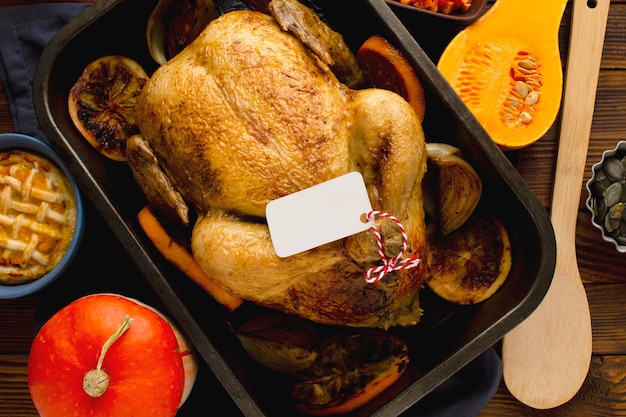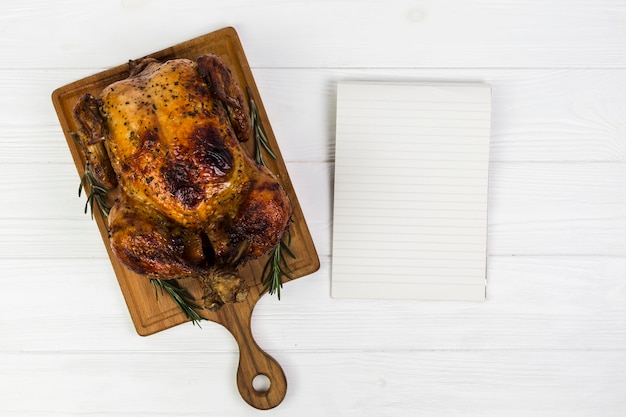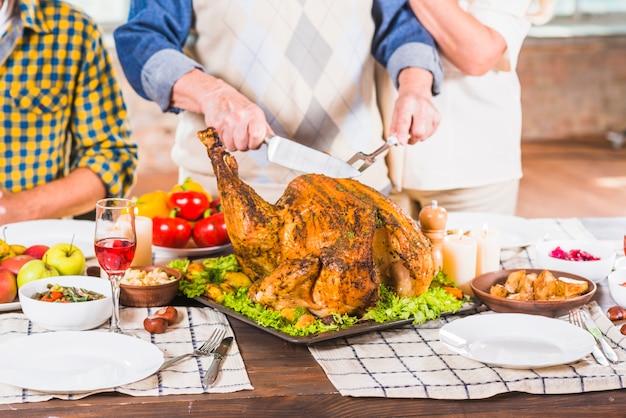Let's be honest, there's nothing quite like the aroma of a perfectly roasted turkey wafting through the house. It's the undisputed star of festive gatherings, a symbol of tradition and togetherness. But, let's face it, conquering the art of the perfect roast turkey can feel like a daunting task. I've been there myself, with a few turkey disasters under my belt – dry, overcooked birds, uneven browning, you name it. But, over time, and with a good dose of trial and error, I've finally cracked the code. And I'm here to share my hard-earned wisdom, so you can confidently tackle any Thanksgiving table, Christmas dinner, or any other occasion demanding a show-stopping turkey.
This isn't just a recipe guide; it's a comprehensive journey into the world of oven-roasted turkey. We'll cover everything from choosing the right bird to mastering the perfect roasting technique, and of course, we'll sprinkle in some of my favourite recipes along the way. So, grab a cuppa, get comfortable, and let's dive in!
(Part 1) Choosing the Right Turkey

The foundation of a delicious roast turkey lies in selecting the right bird. I've learned the hard way that not all turkeys are created equal!
The Different Types of Turkeys
When you're browsing the butcher's or supermarket, you'll encounter a few main types of turkeys:
- Fresh turkeys: These are your standard, unfrozen turkeys. They're a great choice if you're planning ahead and can get them fresh from the butcher's or supermarket. Just be sure to store them properly in the fridge until you're ready to cook.
- Frozen turkeys: Frozen turkeys come in handy if you're not buying your turkey in advance. Just remember to allow plenty of time for thawing. The general rule is to thaw a turkey in the fridge for about 24 hours for every 5 pounds of weight.
- Brined turkeys: Brined turkeys have been soaked in a salt water solution, which helps to keep them incredibly moist and tender. You can buy them pre-brined or even brine your own. If you're a beginner, I recommend sticking to a pre-brined turkey. It saves you time and effort, and the results are consistently fantastic.
- Free-range turkeys: Free-range turkeys are raised outdoors, enjoying fresh air and space. They often boast a richer, more intense flavour than their conventionally raised counterparts, but can be more expensive. If you're looking for the best possible taste, consider giving them a go.
Size Matters: Choosing the Right turkey weight
Now, when it comes to size, don't just go for the biggest turkey you can find. Choose a size that's appropriate for the number of people you're feeding. A good rule of thumb is to allow about 1 pound of turkey per person. Remember, leftovers are a welcome bonus!
I usually opt for a turkey between 12-16 pounds. It's a good size for a family gathering, leaving enough room for all the delicious side dishes. But don't be afraid to go bigger or smaller, depending on your needs.
(Part 2) Preparing Your Turkey

Once you've chosen your turkey, it's time to get it ready for roasting. This might sound simple, but there are a few crucial steps to ensure a flawless roasting experience.
Thawing Your Turkey (If Necessary)
If you've bought a frozen turkey, you'll need to thaw it completely before you can roast it. As I mentioned, thaw it in the fridge, giving it ample time. You can also thaw it in a cold water bath, but make sure the water is constantly changing. Never thaw your turkey at room temperature, as this can encourage bacterial growth. You'll know your turkey is thawed when the flesh is completely thawed and there are no ice crystals left in the cavity.
Patting Your Turkey Dry
Once your turkey is thawed, pat it dry with paper towels. This simple step will help to ensure a crispy skin and prevent the turkey from steaming in the oven.
Stuffing Your Turkey (Optional)
Whether or not to stuff your turkey is a matter of personal preference and tradition. Some folks love the flavour and ritual of stuffing, while others prefer to cook it separately. If you're stuffing your turkey, use a good quality stuffing recipe and make sure to cook it thoroughly. Overstuffed turkeys can take longer to cook, and the stuffing might not be cooked through. I personally prefer to cook my stuffing separately, as it allows me to keep a closer eye on it.
Seasoning Your Turkey
This is where you get to let your culinary creativity shine! I like to keep things simple with a basic rub of salt, pepper, and herbs. You can also use a ready-made seasoning blend or create your own custom blend. Whatever you choose, be sure to season generously, both inside and out. If you're using a brine, you can skip the salt and just season with pepper and herbs.
(Part 3) Roasting Your Turkey

Now, onto the main event: roasting your turkey. With the right technique, you'll achieve that gorgeous golden-brown skin and juicy, tender meat.
Preheating Your Oven
The first step to roasting a turkey is to preheat your oven to 325°F (160°C). This ensures that the turkey cooks evenly and doesn't get stuck in the 'warm up' phase for too long.
roasting time
The roasting time will depend on the size of your turkey. As a general rule, you should allow 15 minutes per pound for an unstuffed turkey and 20 minutes per pound for a stuffed turkey. For example, a 12-pound unstuffed turkey will take about 3 hours to roast. I always check the turkey's internal temperature to make sure it's cooked through.
Basting Your Turkey
Basting your turkey helps to keep it moist and adds flavour. You can baste with butter, chicken broth, or even a simple mixture of water and herbs. I prefer to baste with butter and herbs for a richer flavour.
Checking for Doneness
The best way to check if your turkey is cooked through is to use a meat thermometer. Insert the thermometer into the thickest part of the thigh, making sure it doesn't touch any bones. The turkey is done when the internal temperature reaches 165°F (74°C).
Resting Your Turkey
Once your turkey is cooked, let it rest for at least 15 minutes before carving. This allows the juices to redistribute throughout the meat, resulting in a more tender and juicy turkey.
(Part 4) Carving Your Turkey
carving a turkey can be a bit intimidating, but with a few tips, you can do it like a pro.
Tools of the Trade
You'll need a sharp carving knife and a carving fork for this task. It's also helpful to have a cutting board that's large enough to accommodate the turkey.
The Steps
1. Place the turkey on the cutting board and use the carving fork to hold it in place.
2. Start by removing the legs and thighs. Use the carving knife to cut along the joint between the leg and the body, then cut through the skin to separate the leg.
3. Remove the wings by cutting along the joint where the wing meets the body.
4. Cut the breast meat from the bone. Start by cutting along one side of the breastbone, then carefully slice the meat away from the bone.
5. Slice the breast meat into thin slices.
(Part 5) turkey gravy
Who doesn't love a good turkey gravy? It's the perfect way to soak up all those delicious turkey juices.
Making the Gravy
1. Remove the turkey from the roasting pan and set it aside to rest.
2. Pour the pan drippings into a heat-proof measuring cup or jug. Let the drippings settle for a few minutes, then skim off any excess fat.
3. Whisk together the drippings, flour, and broth in a saucepan. Cook over medium heat, whisking constantly, until the gravy thickens.
4. Season the gravy with salt and pepper to taste. You can also add other seasonings, like herbs or garlic, if you like.
(Part 6) Serving Your Turkey
Now, it's time to showcase your culinary masterpiece. The moment of truth!
Presentation is Key
A beautifully presented turkey is a feast for the eyes, as well as the stomach. Arrange the carved turkey on a platter with a side of gravy, stuffing, and your favourite side dishes.
Don't Forget the Sides
No turkey is complete without a selection of delicious sides. My go-to side dishes include mashed potatoes, roasted vegetables, cranberry sauce, and green bean casserole.
(Part 7) Leftovers: Don't Waste a Bit!
Oh, the joys of turkey leftovers! This is where the real fun begins.
turkey sandwiches
These are a classic for a reason! They're simple, satisfying, and perfect for a quick lunch or dinner.
turkey soup
Leftover turkey is the perfect base for a hearty and comforting soup.
turkey salad
This is a great way to use up leftover turkey and it's perfect for salads or sandwiches.
(Part 8) Oven-Roasted turkey recipes
Ready to get cooking? Here are some of my favourite oven-roasted turkey recipes:
Classic Herb-Roasted Turkey
This is a classic recipe for a reason. It's simple, delicious, and always a crowd-pleaser.
Ingredients:
- 1 turkey (12-16 pounds)
- 1 tablespoon salt
- 1 teaspoon black pepper
- 1 teaspoon dried thyme
- 1 teaspoon dried rosemary
- 1 teaspoon dried sage
- 1/2 cup butter, melted
Instructions:
- Preheat oven to 325°F (160°C).
- Pat the turkey dry with paper towels.
- In a small bowl, combine the salt, pepper, thyme, rosemary, and sage. Rub the seasoning mixture all over the turkey, both inside and out.
- Place the turkey in a roasting pan. Pour the melted butter over the turkey.
- Roast for 15 minutes per pound for an unstuffed turkey or 20 minutes per pound for a stuffed turkey.
- Baste the turkey with pan drippings every 30 minutes.
- Check the turkey's internal temperature with a meat thermometer. The turkey is done when the internal temperature reaches 165°F (74°C).
- Let the turkey rest for 15 minutes before carving.
Sage and Onion-Stuffed Turkey
This recipe is a favourite for those who love a good stuffing.
Ingredients:
- 1 turkey (12-16 pounds)
- 1 tablespoon salt
- 1 teaspoon black pepper
- 1 teaspoon dried thyme
- 1 teaspoon dried rosemary
- 1 teaspoon dried sage
- 1/2 cup butter, melted
- 1 onion, chopped
- 2 cups bread cubes
- 1 cup chicken broth
- 1/2 cup chopped fresh sage
- 1/4 cup chopped fresh parsley
Instructions:
- Preheat oven to 325°F (160°C).
- Pat the turkey dry with paper towels.
- In a small bowl, combine the salt, pepper, thyme, rosemary, and sage. Rub the seasoning mixture all over the turkey, both inside and out.
- Place the turkey in a roasting pan. Pour the melted butter over the turkey.
- In a large bowl, combine the onion, bread cubes, chicken broth, sage, and parsley. Mix well.
- Stuff the turkey with the stuffing mixture.
- Roast for 20 minutes per pound.
- Baste the turkey with pan drippings every 30 minutes.
- Check the turkey's internal temperature with a meat thermometer. The turkey is done when the internal temperature reaches 165°F (74°C).
- Let the turkey rest for 15 minutes before carving.
Garlic and Herb-Roasted Turkey
This recipe is a delicious twist on the classic herb-roasted turkey. It's packed with flavour and is sure to impress your guests.
Ingredients:
- 1 turkey (12-16 pounds)
- 1 tablespoon salt
- 1 teaspoon black pepper
- 1 teaspoon dried thyme
- 1 teaspoon dried rosemary
- 1 teaspoon dried sage
- 1/2 cup butter, melted
- 4 cloves garlic, minced
- 1/4 cup chopped fresh parsley
Instructions:
- Preheat oven to 325°F (160°C).
- Pat the turkey dry with paper towels.
- In a small bowl, combine the salt, pepper, thyme, rosemary, sage, garlic, and parsley. Rub the seasoning mixture all over the turkey, both inside and out.
- Place the turkey in a roasting pan. Pour the melted butter over the turkey.
- Roast for 15 minutes per pound for an unstuffed turkey or 20 minutes per pound for a stuffed turkey.
- Baste the turkey with pan drippings every 30 minutes.
- Check the turkey's internal temperature with a meat thermometer. The turkey is done when the internal temperature reaches 165°F (74°C).
- Let the turkey rest for 15 minutes before carving.
(Part 9) FAQs
Let's tackle some common questions about roasting a turkey.
1. How do I prevent my turkey from drying out?
Dry turkey is a common problem, but it's easily avoidable. The key is to keep the turkey moist throughout the cooking process. Brining your turkey is a fantastic way to do this. If you're not brining, make sure to baste the turkey regularly. You can also try using a roasting bag, which helps to trap in moisture.
2. How do I get crispy skin?
Crispy skin is a must-have for any roast turkey. The secret lies in getting the skin nice and dry before roasting. Pat the turkey dry with paper towels, and don't be afraid to lift the skin and pat the meat underneath as well. You can also try rubbing the skin with a little bit of olive oil or butter.
3. What if my turkey is too big for my oven?
If your turkey is too large for your oven, you can roast it in two parts. Simply separate the breast from the legs and thighs, and roast each part separately.
4. Can I freeze leftover turkey?
Yes, you can freeze leftover turkey. Wrap it tightly in plastic wrap or aluminum foil and place it in a freezer-safe bag. It can be frozen for up to 3 months.
5. What if my turkey is overcooked?
If your turkey is overcooked, don't worry! It's not the end of the world. You can still carve it and serve it, but it might be a bit dry. To help with the dryness, you can add some gravy or sauce to the turkey.
There you have it, folks. The ultimate guide to oven-roasted turkey, packed with tips, tricks, and recipes. Now, go forth and conquer the Thanksgiving table, Christmas dinner, or any other occasion that calls for a show-stopping turkey. You've got this!
Everyone is watching

Corn on the Cob: The Ultimate Guide to Perfectly Cooked Ears
Healthy MealsAh, corn on the cob. Just the name evokes images of sunny days, barbecues, and that sweet, juicy flavour that ...

Scallops: The Ultimate Guide to Perfect Cooking
Healthy MealsAh, scallops. Those delicate, sweet, and utterly delicious morsels of the sea. They hold a special place in my...

Spaghetti Squash: The Ultimate Guide to Cooking and Serving
Healthy MealsRemember that time you saw spaghetti squash at the supermarket, looking all bumpy and strange, and thought, "W...

Salmon Cooking Times: Perfect Guide for Every Recipe
Healthy MealsLet me tell you, cooking salmon is an art form. It's all about getting that perfect balance: juicy and tender,...

Ham Cooking Time: How Long to Bake, Smoke, or Boil a Delicious Ham
Healthy MealsAh, ham. It's a classic, isn't it? A real crowd-pleaser, especially around holidays. And when done right, it'...
